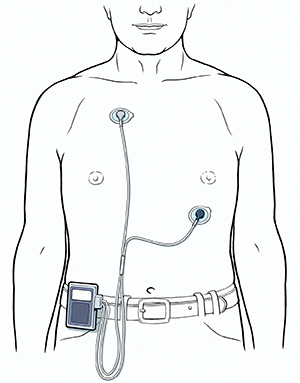Using an Event Monitor
Using an Event Monitor

How an event monitor works
An event monitor uses small sticky pads (electrodes) stuck to your chest. These connect by wires to the monitor device. The device records the same kind of information as an electrocardiogram (EKG). But it does it for longer periods of time, usually at least 1 minute. The monitor records when you activate it. Some event monitors will automatically start recording if they detect an abnormal heart rhythm. Most of these devices can send the information right to your healthcare provider. Others require that the data be downloaded.
Why an event monitor is used
A healthcare provider may think that you have an abnormal heart rhythm based on your medical history, even if your EKG looks normal. Some abnormal heart rhythms happen less often and only for a short time. In this case, an EKG is not likely to pick up the abnormal heart rhythm. An event monitor may be a better option for you. That way, you can record your heart’s electrical activity when you are having symptoms. The event monitor can also help show what type of abnormal rhythm you have. It's best for rhythm abnormalities that happen now and then or that are caused by certain symptoms.
You may need to wear an event monitor if:
Your heartbeat is too fast, too slow, or irregular
You have symptoms, such as palpitations, dizziness, or fainting, or feel your heart is beating too hard or skipping a beat
Your healthcare provider wants to check how well the treatment for an abnormal heart rhythm is working. You may have to wear a monitor following an ablation or cardioversion to see that your heart is still in a normal rhythm following these types of treatments.
You have had an open heart surgery such as a heart valve replacement or repair or bypass grafting. The heart muscle can become irritated and more likely to have irregular heart rhythms as you recover at home.
Risk of using an event monitor
Event monitors are generally very safe. They don’t cause any pain. In some cases, the sticky patches used to attach the sensors to your chest can cause skin irritation.
Getting your event monitor
Your healthcare provider will show you how to use your event monitor. Different types of event monitors work in different ways. Cardiac memory loop monitors have sensors that attach to your chest using sticky patches. Wires connect these sensors to a monitor, which you can usually put on your belt or in your pocket.
Before you put your sensors on your chest, your skin should be free of oils, creams, and sweat. Clean your skin before putting them on. You may need to shave the area before applying. A technician will show you how to place the electrodes. Follow all instructions about exercise. Sweat can make the sensors come off. If you have a cardiac loop monitor, change your sensors as instructed.
You may need to wear your event monitor for several days or up to a month. You will also need to keep a diary while using your event monitor. Record any symptoms when they happened, and note what you were doing at the time.
When it’s time to record an event
When you have a symptom, push the button to start recording. (Some start recording automatically when an abnormal rhythm is detected.)
Stop moving. This will help the device get a good recording. The device should record for several minutes.
After the event, write down the time, your symptoms, and what you were doing when the event happened.
After recording an event
For some event monitors, you will need to send your recordings over the phone to your healthcare provider. Someone will review your recording. In some cases, you may need to go see your healthcare provider.
Using other electronic devices
Some electronic devices can disrupt the monitor. If you can, avoid using these during the time you’re wearing the monitor. But when you need to use an electronic device, keep it at least 6 inches away from the monitor. This includes things such as:
Cell phones
Electric blankets
Electric razors
Electric toothbrushes
iPods
Magnets
Metal detectors
Microwave ovens
Note: Large motors or construction equipment should also not be used near the monitor. They can cause interference and vibrations that can be mistaken as irregular heart rhythms by the monitor.
Treatment after an event monitor
After a few readings, you may be able to stop wearing your event monitor. Your healthcare provider may use those readings to start your treatment. In some cases, you may need more testing. Follow-up tests might include:
Exercise stress test. This show how your heart responds to exercise and how well it handles increased oxygen demands.
Tilt-table test. This may be done if you have had fainting.
Electrophysiological testing. This can give more information about your heart’s electrical signal.
Echocardiogram. This is done to evaluate the structure and pumping function of your heart and its valves.
Updated:
March 21, 2017
Sources:
Zimetbaum, Peter. Utility of Patient-Activated Cardiac Event Recorders in General Clinical Practice. The American Journal of Cardiology. 1997:79; 3rd ed., pp. 371-372.
Reviewed By:
Gandelman, Glenn, MD, MPH,Image reviewed by StayWell medical illustration team.,Snyder, Mandy, APRN